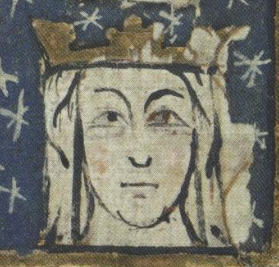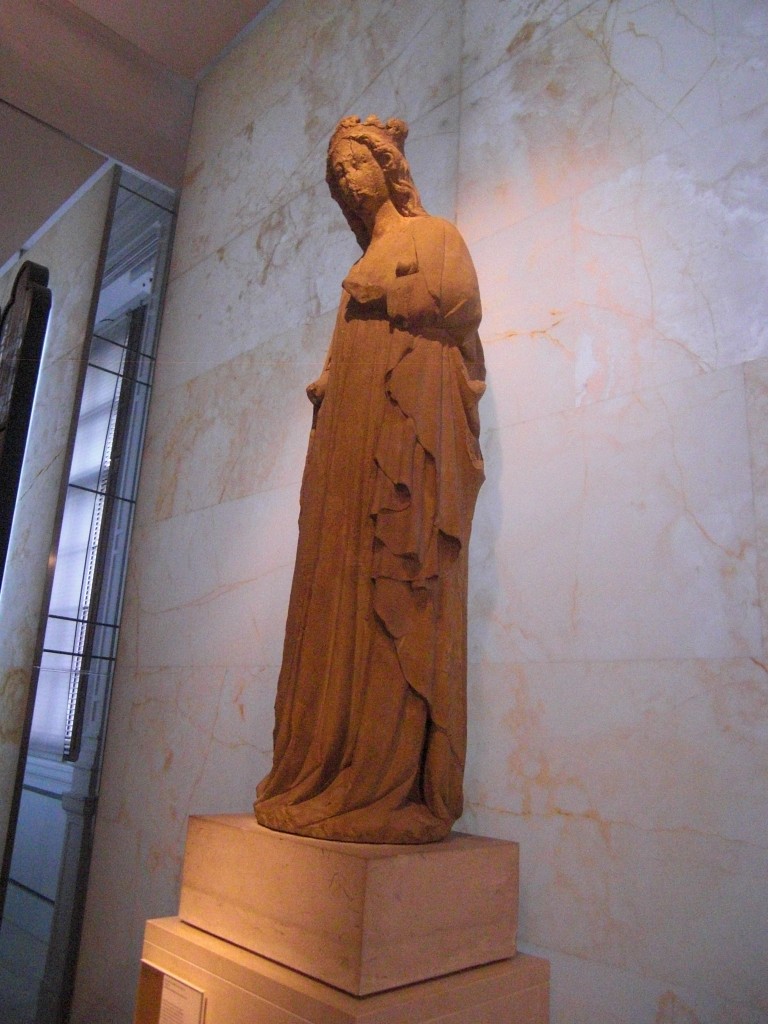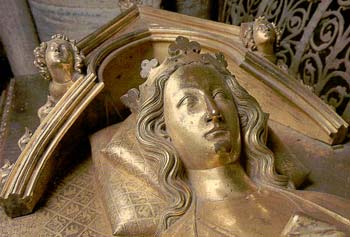by Susan Flantzer
© Unofficial Royalty 2013

Eleanor of Castile, Queen of England; Photo Credit – Wikipedia
Born in 1241, Eleanor of Castile, first wife of King Edward I of England, was the daughter of (Saint) King Ferdinand III of Castile and his second wife Jeanne de Dammartin, Countess of Ponthieu in her own right. She was the second child of her parents’ five children.
Eleanor’s siblings:
- Ferdinand II, Count of Aumale (1239–ca 1265), married Laure de Montfort, Lady of Espernon, had issue
- Louis (1243–ca 1275), who married Juana de Manzanedo, Lady of Gaton, had issue
- Simon (born and died 1244)
- John (born and died 1246)
Eleanor also had ten half-siblings from her father’s first marriage to Elisabeth of Swabia:
- King Alfonso X of Castile and Leon (the Wise) (1221 – 1284), married Violante of Aragon, had issue
- Infante Fadrique of Castile and Leon (1223 – 1277), executed by his brother Alfonso
- Infante Ferdinand of Castile and Leon (1225 – 1248)
- Infanta Eleanor of Castile and Leon (born and died 1226)
- Infanta Berengaria of Castile and Leon (1228 – 1279), a nun at the Cistercian monastery Santa María la Real at Las Huelgas
- Infante Enrique of Castile and Leon (1230 – 1303), married Juana Núñez de Lara, had issue
- Infante Felipe of Castile and Leon (1231 – 1274), married (1) Christina of Norway, no issue (2) Inés Rodríguez Girón, no issue (3) Leonor Rodríguez de Castro, had issue
- Infante Sancho of Castile and Leon (1233 – 1261), Archbishop of Toledo
- Infante Manuel of Castile and Leon (1234 – 1283), married (1) Constance of Aragon, had issue (2) Beatrice of Savoy, had issue
- Infanta Maria of Castile and Leon (born and died 1235)
13-year old Eleanor married 15-year old Edward of Westminster, the future King Edward I of England and the son of King Henry III of England and Eleanor of Provence on November 1, 1254, at the Abbey of Santa María la Real de Las Huelgas in the Kingdom of Castile, now in Spain. Edward and Eleanor had a loving marriage and were inseparable throughout their married life. Edward is one of the few English kings of the time to be faithful to his wife. Eleanor accompanied her husband on Crusade and other military campaigns. In 1272, Edward succeeded his father King Henry III. Edward and Eleanor were crowned in Westminster Abbey on August 19, 1274, the first king and queen to participate in a coronation together since the Norman Conquest. The couple had 14-16 children, but only six survived childhood.
- Daughter (stillborn in May 1255)
- Katherine of England (before 1264 – 1264)
- Joan of England (born and died 1265)
- John of England (1266 – 1271)
- Henry of England (1268 – 1274)
- Eleanor of England (1269 – 1298), married Henri III, Count of Bar, had issue
- Daughter (born and died 1271)
- Joan of Acre (1272 – 1307), married (1) in 1290 Gilbert de Clare, 6th Earl of Hertford, had issue (2) in 1297 Ralph de Monthermer, 1st Baron Monthermer, had issue
- Alfonso, Earl of Chester (1273 – 1284)
- Margaret of England (1275 – after 1333), married John II of Brabant, had issue
- Berengaria of England (1276 – 1278)
- Daughter (born and died 1278)
- Mary of Woodstock (1279 – 1332), a Benedictine nun in Amesbury, Wiltshire
- Son (born in 1280 or 1281 who died very shortly after birth)
- Elizabeth of Rhuddlan (1282 – 1316), married (1) in 1297 John I, Count of Holland, no issue (2) in 1302 Humphrey de Bohun, 4th Earl of Hereford, 3rd Earl of Essex, had issue
- King Edward II of England (1284 – 1327), married Isabella of France, had issue
In the autumn of 1290, King Edward I of England heard of the death of Margaret, the Maid of Norway, the seven-year-old heir to the Scots throne, who died while traveling from Norway to Scotland. Edward had been attending a session of Parliament in Nottinghamshire and decided to stay in the north of England, most likely to hear news of what would happen in Scotland. His queen, Eleanor of Castile, was following him north at a leisurely pace. On her way to Lincoln, Eleanor became ill and as she reached the village of Harby in Nottinghamshire, 22 miles from Lincoln, she could go no further, so she sought lodging at the house of Richard de Weston in Harby. Eleanor’s condition worsened and messengers were sent to summon the king to her bedside. King Edward arrived in Harby before Eleanor died in the evening of November 28, 1290. Eleanor was 49 years old, had been married to Edward for 36 years, and had given birth to 14-16 children.
King Edward I was devastated when Eleanor died. Eleanor’s body was taken to the Gilbertine Priory of St. Catherine in Lincoln, where she was embalmed. Her viscera were buried at Lincoln Cathedral and her body was then taken to London, where Eleanor was to be interred at Westminster Abbey. It took 12 days to reach London and twelve crosses, known as Eleanor Crosses, were erected at the places where her funeral procession stopped overnight. Charing Cross in London is perhaps the most famous, but the cross there is a reconstruction. Only three original crosses survive although they have had some reconstruction: Geddington Cross, Hardingstone Cross, and Waltham Cross.

Original Eleanor Cross, in Geddington, England; Credit – Wikipedia

Statue of Eleanor of Castile which was part of the Eleanor Cross at Waltham, Hertfordshire, England; Victoria and Albert Museum in London; Photo Credit – Susan Flantzer 2015
On December 17, 1290, Eleanor’s funeral was held at Westminster Abbey. Temporarily, she was buried in a grave near the high altar that had originally contained the coffin of Edward the Confessor and that of her father-in-law King Henry III until their remains were placed in their tombs. Eleanor’s body remained in this grave until the completion of her own tomb. The tomb is a marble chest with carved moldings and shields of the arms of England, Castile, and Ponthieu which were originally painted. On top of the tomb is Eleanor’s beautiful bronze effigy.
England: House of Plantagenet Resources at Unofficial Royalty
- United Kingdom of Great Britain and Northern Ireland Index
- House of Plantagenet Index (1216 – 1399)
- British Royal Births, Marriages, Deaths, and Other Important Events
- Coronations after the Norman Conquest (1066 – present)
- History and Traditions: Norman and Plantagenet Weddings
- House of Plantagenet Burial Sites
This article is the intellectual property of Unofficial Royalty and is NOT TO BE COPIED, EDITED, OR POSTED IN ANY FORM ON ANOTHER WEBSITE under any circumstances. It is permissible to use a link that directs to Unofficial Royalty.

